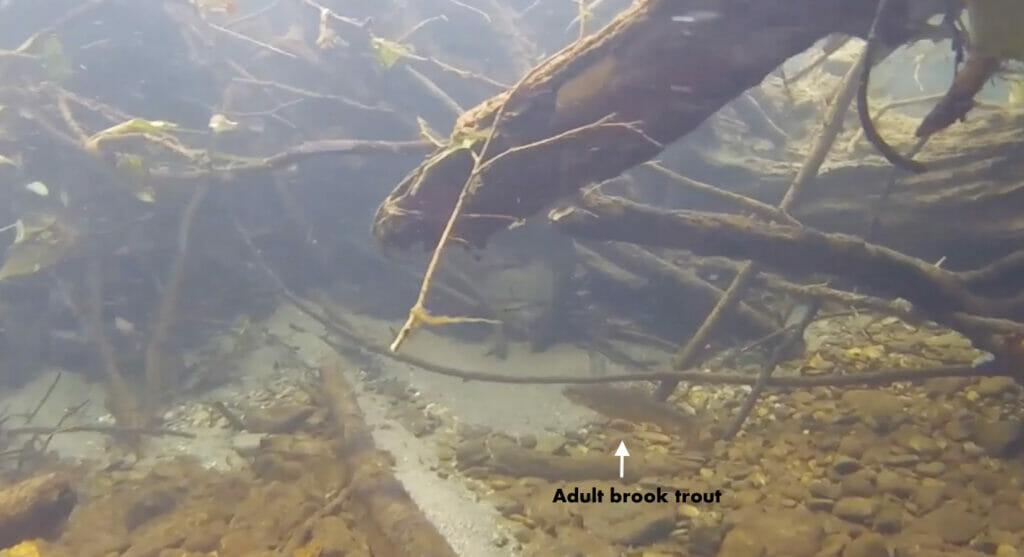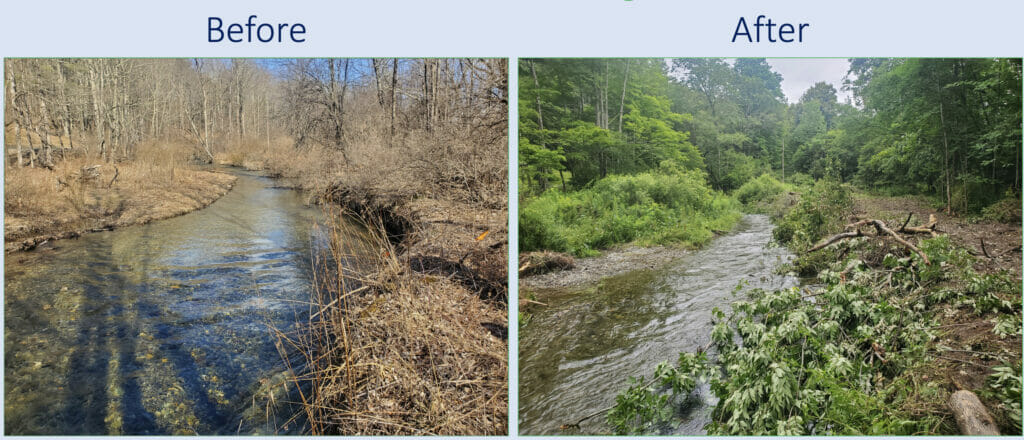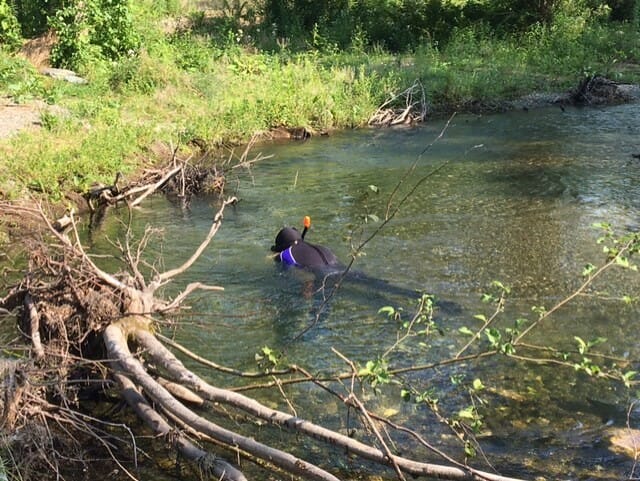By Jacob Fetterman
Fish data, specifically trout population data, is integral to Trout Unlimited’s work.
Earlier this summer, I was brainstorming how we could ensure we are properly monitoring trout numbers in relation to the Battenkill Home Rivers Initiative.
The Battenkill Home Rivers Initiative is a concentrated effort to protect, reconnect and restore the Battenkill watershed. It brings TU’s national mission to a specific watershed in order to have the greatest impact.
I have watched snorkel surveys done before and always thought, “Wow, wouldn’t that be something to immerse yourself in the stream with the fish you’re working so hard to protect, in the habitat we are restoring?”
In the absence of electrofishing gear, actually getting into the water and counting fish is the next best method for gathering the data I needed.
Things started falling into place when I learned that Seavenger was interested in donating snorkel gear for us to use in the field. Seavenger ended up donating 40 sets. I received two sets complete with fins, goggles and snorkels.
To prepare, I reviewed various snorkel survey protocols and landed on “Snorkel Surveys,” by Jennifer O’Neal (2007) in Salmonid Field Protocols Handbook. This protocol is excellent and provided a template data sheet from which I adapted to meet the needs of our studies.
I would be surveying a reach on Camden Creek. The eventual plan for the creek included adding large wood in strategic locations to make trout habitat better. That work started in July.
This tributary is one of our highest priorities for restoration. It was selected due to its cold, clean water, brook trout presence and the known presence of spawning trout..
In 2020, we completed the Battenkill HRI’s first project on Camden Creek, restoring floodplain connectivity, sinuosity, and bed-form diversity. This summer’s project is an upstream extension of last year’s project.
I needed two final things before doing my first snorkel survey: One, a wetsuit or enough bravado to help get into sub-sixty-degree water without one, and, two, someone to help out by recording data from the stream bank.
Luckily, my girlfriend’s cousin was generous enough to lend me her wetsuit (thank you, Kate!). Samuel Levine, one of our field technicians, was available to help with data recording.
The rest would be easy, right?
By mid-morning on July 1 the air temperature was about 70 degrees. The water temperature in Camden Creek was a touch over 56 degrees. Great for trout, but not so great for me, a warm-blooded mammal — even enclosed in neoprene.

As soon as I submerged myself in a downstream pool to calibrate my eyes for sizing fish and to measure my visibility, I knew it was going to be a frigid endeavor.
At first, I thought my breathing was compromised — it had been a while since I donned a snorkel. But then I realized that it was in fact a mild case of cold shock, and I was desperate for more oxygen.
After I warmed up a bit with jumping jacks, Sam and I started a survey on the first of two reaches.
Immediately, in the first pool, I was amazed by what I saw — several young-of-the-year trout in the tail-out and progressively larger trout (up to about 5 inches) as I belly crawled my way along to the head of the pool. (Being in a smaller stream, I traded in the fins for elbow and knee pads.)
This effort wasn’t a test of will, nor was it just so I could swim with trout. It was a scientific study. This data is part of what we will use to monitor our projects’ effectiveness.
The underwater perspective when snorkeling a stream is simply incredible. Bed contours are much more defined than they appear from the bank, and even a few small over-hanging branches provide great habitat for small trout.
As I went along, the excitement of interacting with these amazing fish kept me as warm as it could, but I was still forced to take a couple brief stream-side jumping-jacks breaks throughout the three hours of snorkeling. In GoPro videos you can hear my deep breathing and see my hand holding the camera was shaking almost uncontrollably.
The data and GoPro camera footage I recorded during the survey made freezing worth it.
This effort wasn’t a test of will, nor was it just so I could swim with trout. It was a scientific study. This data is part of what we will use to monitor our projects’ effectiveness.
The first reach surveyed on July 1 was one that had been electrofished by New York State Department of Environmental Conservation in 2020. They found that there were 392 trout per acre (216 adults; 177 young-of-the-year). In my 2021 snorkel survey, I observed 499 trout per acre (132 adults; 367 young-of-the-year).

The other reach surveyed on July 1 was farther upstream on Camden Creek. We documented 507 trout per acre (171 adult; 337 young-of-the-year). I am excited to re-survey the reach next year after the wood additions have been in the stream for a year.
On July 29, I surveyed a third reach on Camden Creek, the bulk of it part of our 2020 restoration project. That survey produced 684 trout per acre (498 adult; 186 young-of-the-year fish). Footage from this survey was compiled into another short film shared on the Battenkill Home Rivers Initiative social media pages.
I was able to stay warmer on the July 29 survey — a friend found a hooded wetsuit at Goodwill and bought it for me. The hood was a game-changer. Now I can look forward to next summer’s survey without having to worry about stopping to do jumping-jacks.
Jacob Fetterman is the coordinator for Trout Unlimited’s Battenkill Home Rivers Initiative. To learn more about the effort, reach out to him at jacob.fetterman@tu.org.



